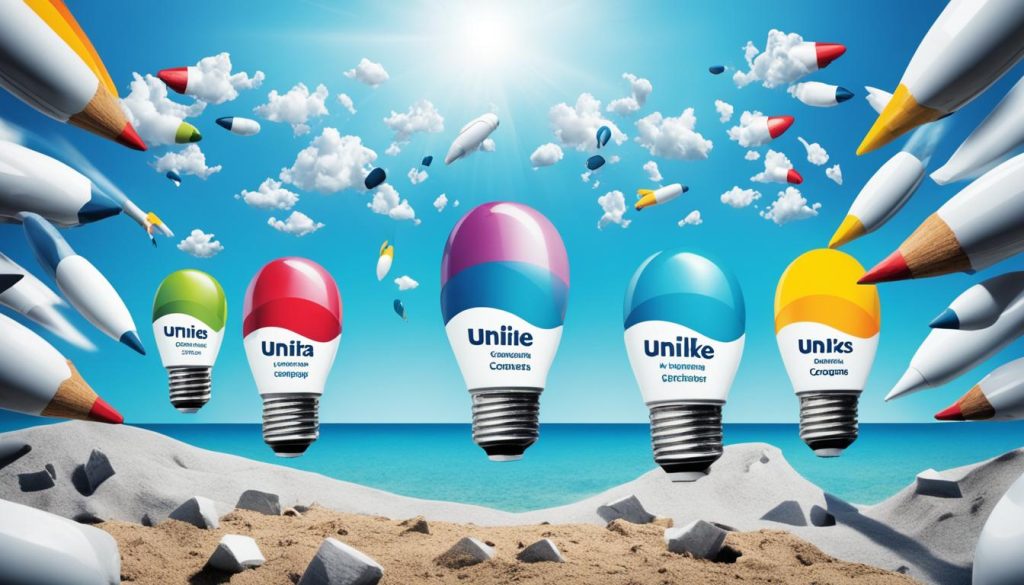In today’s tough business scene, gaining a competitive edge is key to be a market leader. Innovative differentiation is a powerful strategy. It merges product innovation with unique features to create a special selling point. This method combines launching improved products or services with a focus on uniqueness.
Staying relevant in changing market conditions is vital. Early wins don’t mean lasting success. Companies need to keep innovating and setting themselves apart to stay ahead. By adding value through unique features, firms can compete without relying on price alone. This helps build a strong brand connection.
Apple is a great example of this. They often update and release new products. This shows how ongoing innovation keeps customers coming back.
Key Takeaways
- Combining product innovation with distinctive attributes enhances a competitive advantage.
- Continued relevance in the market requires persistent innovation and differentiation.
- Creating value through differentiation based on cost and perceived value is essential.
- Non-price competition can give an edge in oligopolistic markets.
- Consistent innovation fosters brand loyalty, as demonstrated by Apple.
Understanding Innovative Differentiation
Innovative differentiation is key to business success. By using new technologies, companies can create unique products. This helps them stand out and tackle future challenges.
Definition and Importance
Innovative differentiation means making products or services that are better. They have unique features that beat the competition. This way, companies can build a strong market presence. It’s about solving problems today and preparing for tomorrow. Firms that do this tend to succeed in the long run.
Historical Context
In the past, being different was crucial for companies in competitive markets. Companies like Apple led the way. They combined new technology with great design. Their strategy made them market leaders. It shows the power of staying innovative.
The Role of Product Innovation

In today’s fast-moving market, creating new products is key to success. Companies meet new customer needs by offering new or better products. This keeps their demand high.
By always advancing in technology, companies can lead the competition. This is crucial for staying relevant and favored by customers.
Introduction to Product Innovation
Product innovation means bringing new or improved items to the market. It aims to improve how users feel about a product and match what people want. Through fresh design and technology, products can truly meet consumer desires.
This ensures customers are happy and keep coming back. It’s all about offering something unique and useful.
Examples of Successful Product Innovations
Many famous brands show the power of product innovation. For example, Apple updates its iPhone with new tech, improving how it works. Tesla, on the other hand, makes electric cars that are both eco-friendly and stylish.
These innovations meet demands for better technology and sustainability. They also offer outstanding performance and looks.
Strategies for Effective Product Differentiation
Brands need strong product differentiation strategies to stand out, reach diverse customers, and cater to their unique needs. Differentiation can happen in many ways that fit a company’s goals and the market. This makes their products stand out in a crowded market.
Vertical Differentiation
Vertical differentiation is about offering products of different quality and performance. Companies provide items at various prices to attract different customers. For example, releasing a premium version of a product can target those wanting high quality and features.
Horizontal Differentiation
Horizontal differentiation meets various tastes without changing product quality. It helps brands attract more people by providing different options. Brands like Unilever use this strategy, offering many ice cream flavours to please different tastes.
Mixed Differentiation
Mixed differentiation uses elements of both vertical and horizontal strategies. It helps meet diverse preferences while keeping quality differences. With this, companies can hold a strong market position, boost customer loyalty, and segment the market effectively.
Benefits of Product Differentiation

Product differentiation brings many advantages to businesses, notably improving their place in the market. It lets companies target specific consumer groups, increasing their loyalty and making the brand more recognised.
When products are unique, consumers have more choices. They find options that meet their specific needs. This strategy draws in different consumer groups and builds strong bonds with them, improving the shopping experience for everyone.
Differentiation also means better profits for businesses. With unique products, companies can set higher prices, leading to bigger profits and steady growth. It also reduces head-to-head competition, helping businesses stay ahead and succeed in the long run. These advantages significantly boost the brand’s position and strength in a competitive environment.
- Heightened brand loyalty
- Premium pricing potential
- Enhanced competitive edge
- Capturing market niches
Non-Price Competition as a Differentiation Strategy
Non-price competition is key in today’s businesses. It focuses on more than just price. This lets companies use their brand to stand out.
They highlight things like product quality and brand image. This way, companies in competitive markets can gain an edge without starting price wars.
Understanding Non-Price Competition
Companies shine by highlighting unique features, not just low prices. This strategy boosts things like quality and brand identity. It helps companies stand out and win loyal customers.
Examples of Non-Price Competition
Famous brands like Apple rely on non-price competition. They focus on quality design and innovation. This sets them apart even with higher prices.
Lush and The Body Shop also use this approach. They emphasize ethical practices and top-quality products. This strategy strengthens their brand and gives them a competitive edge.
Creating Value Through Differentiation
Brands must stand out to stay on top. They do this by making their products more than just affordable. This way, they lift their offerings above simple price tags.
Customer Perception and Value
Understanding what customers think is vital. People love products that stand out for their quality and benefits. By meeting unique needs, companies can make a great impression and win over customers.
Take Dyson, for example. They’ve managed to create products that go beyond what people expect. This dedication has built them a strong following.
Price vs. Value Strategic Approaches
Pricing needs smart thinking, beyond just being cheap. Firms should use value-based pricing. It means charging based on what customers believe the product is worth. This tactic is seen in how Apple prices its products. They’re more expensive but offer innovation and earn customer loyalty.
Effective value perception and pricing strategies boost a brand’s position and customer dedication. Adopting these methods helps businesses stay ahead, resilient, and loved.
Brand Loyalty and Differentiation
Brand loyalty is key. It comes from constant innovation and being different. Making a strong bond with customers is crucial.
This bond keeps customers coming back. It also makes a brand stand out. Emotional ties are very important for loyalty.
Building Brand Loyalty
To keep customers loyal, businesses need to keep creating and being unique. They must offer something special that speaks to consumers. This goes beyond selling things.
Creating an emotional bond is key. It makes customers attach to a brand. This attachment leads to more buys and keeps the brand strong.
Case Study: Apple’s Differentiation Strategy
Apple shows how being different builds loyalty. It keeps bringing out new products. This keeps old customers interested and brings in new ones.
This mix of innovation and knowing what customers want creates loyalty. Apple stands out because it connects with users on a deep level.
The Role of Marketing in Differentiation

Marketing is key in making products stand out in busy markets. It focuses on unique selling points (USP) and shares these effectively. This lets brands connect better with their audience and strengthens their unique position in the market.
Effective Marketing Strategies
Being strategic about marketing is crucial. It involves highlighting what makes a product special. Companies need to share messages that hit home with their customers. This means they must grasp what the market wants, spot customer issues, and show how their product is the best answer.
- Identifying target audience needs
- Crafting engaging and relevant content
- Leveraging multiple communication channels
Communicating Unique Selling Propositions (USP)
At the heart of great marketing is getting the USP across effectively. It’s vital to be clear about what makes your product different. By highlighting what’s new and different, brands forge a strong bond with their audience. This builds trust and loyalty.
- Clearly define your USP
- Consistently integrate USP into all marketing efforts
- Utilise customer testimonials to validate claims
A successful marketing strategy does more than just talk about the USP. It also boosts your brand’s overall message. This helps build lasting relationships with consumers and keeps them coming back.
Examples of Successful Innovative Differentiation
In today’s business world, Apple stands out as a prime example of innovation. Known for its constant stream of new iPhones and devices, it grabs consumer attention. This drives innovation in business.
Apple mixes cutting-edge tech with beautiful design. This meets both the practical and stylistic needs of its users. Its products have earned a sea of loyal customers and a strong market position.
Let’s look at three ways Apple is different in its innovation:
- It uses cool tech like facial recognition and augmented reality.
- It ensures all devices offer a smooth user experience, creating a single ecosystem.
- It rolls out software updates with new features, keeping devices relevant longer.
These efforts show how Apple stands out in a tough market. It keeps focusing on what customers love. This not only keeps Apple ahead but also makes it a model for business innovation studies.
To follow in Apple’s footsteps, companies must focus on never-ending innovation and put customers first. Learning from Apple, businesses can develop strategies that boost growth and make customers happy.
Importance of Continuous Innovation

To stay ahead, firms must always innovate. Markets change, and so must their offerings to meet new needs. This keeps them ready for now and the future.
Keeping Up with Market Trends
Knowing and predicting market trends is crucial. Innovators lead their fields by adapting quickly. This keeps them desired by customers, thanks to knowing what people like.
Staying Ahead of Competitors
Being a trendsetter is vital in a fast-changing market. Innovation strengthens a company’s place and beats competitors by being first with new ideas. It encourages a winning culture, inspiring others to aim high.
Challenges in Innovating and Differentiating
Businesses face a lot of strategic obstacles today. They struggle to stand out because there are too many ads everywhere. This makes it hard for them to show what’s special about their products.
Another big hurdle is how subjective product differences are. Things like luxury, style, and design mean different things to everyone. So, it’s tough to get widely recognised. Companies have to be very careful and manage risk management strategies well to avoid big losses when trying to be different.
Lastly, firms need to find the right mix of sticking to what works and trying new things. They need smart risk management to make sure new ideas don’t cost them too much. In short, they must overcome market barriers, handle risks well, and tackle strategic obstacles to innovate and differentiate successfully.
The Future of Innovative Differentiation
The world of innovative differentiation is always changing. New trends and tech advances play key roles in how companies stay ahead. It’s vital for businesses to adapt to these changes. This ensures they keep their spot in the market and remain attractive to customers.
Upcoming Trends
Customised experiences for consumers are becoming more important. By using data and artificial intelligence, brands can make their offerings more personal. This improves customer loyalty and happiness. Also, looking after the environment is becoming essential. More shoppers want brands that share their green values.
Technological Advances
New tech is reshaping the market. Augmented reality (AR), virtual reality (VR), and the Internet of Things (IoT) allow brands to create unique experiences. Companies using these techs to make engaging experiences will likely gain a big advantage.
To stay ahead, brands need to watch market trends and tech closely. Staying innovative and refining their strategies helps them connect with customers. This helps them stand out in a crowded market.











